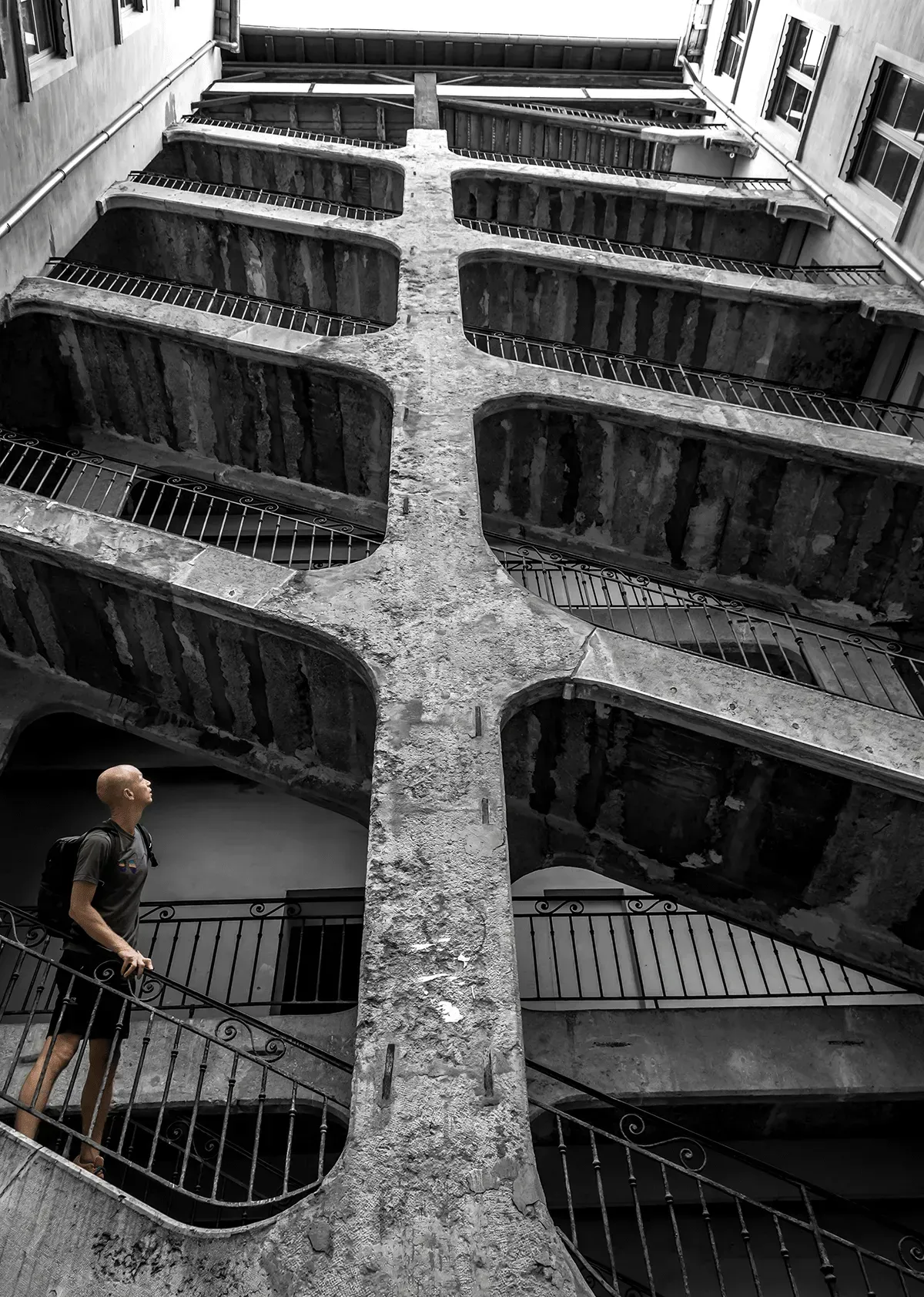From Shadows to Resistance: Lyon’s Traboules in Times of Crisis

As Lyon grew beyond its silk heyday, the traboules remained — not only as architectural relics but as vital arteries of movement, secrecy, and survival. In times of war, protest, and urban change, they served both ordinary citizens and those who fought in the shadows.
The Revolution and Beyond: Changing Urban Roles
By the time of the French Revolution, the silk industry was no longer the only force shaping Lyon’s identity. Yet traboules remained woven into daily life. As the city’s working-class neighborhoods expanded in the 19th century, especially in areas like Croix-Rousse, these hidden passages became the backdrop for political dissent and labor movements. Canuts — Lyon’s silk workers — used them to organize strikes and evade authorities.
Traboules weren’t just shortcuts. They were escape routes for those who needed to slip between buildings unnoticed.
Traboules in World War II: From Stone to Shield
During the Nazi occupation, Lyon became a center of the French Resistance — and traboules were once again repurposed for survival. Resistance fighters used these secret routes to deliver messages, hide from patrols, and escape dangerous encounters. The traboules’ complex layouts and gated entrances became powerful tools for resistance networks operating in Saint-Jean and Croix-Rousse.
Even the Gestapo had trouble navigating Lyon’s traboules — a city where history had long favored those who knew how to disappear.
Preservation or Progress? The 20th Century Debate
Post-war modernization threatened to erase many traboules. Urban planners considered them obsolete or unsafe. But local historians and residents pushed back, recognizing their cultural and historical value. By the late 20th century, some traboules were protected and opened to the public under agreements with the city. Others remained locked, accessible only to residents and the occasional lucky guide.
Closing thread:
As Lyon’s identity shifted from industrial to cultural capital, traboules faced a question familiar to many old cities: how do we keep history alive without turning it into a museum piece? That tension would define the 21st-century fate of these legendary passages.
Unique Tours in Lyon
Offers exclusive and personalized experiences to discover Lyon in a unique way.
From pedicab tours to private walking tours, including thematic experiences like music and Lyon’s cultural heritage, as well as food and wine tasting tours.
We also create custom-made tours, tailored to your interests and needs.
Private Pedicab Tour of Lyon – Explore More, Effortlessly!
Looking for a comfortable, crowd-free way to explore Lyon? Hop on a private pedicab tour and discover the city’s top landmarks with ease! This unique experience lets you see more than a walking tour while avoiding the hassle of large tour buses.
🏛 Discover Lyon’s historic treasures, from bustling Place Bellecour to the elegant Théâtre des Célestins.
🚪 Glide through hidden traboules, the secret passageways of Old Lyon and Croix-Rousse.
📍 Admire architectural gems, including the stunning Saint-Jean-Baptiste Cathedral.
🎧 Enjoy expert commentary
from your private guide, tailored to your interests.
🚴♂️ Relax in an eco-friendly pedicab, perfect for effortless sightseeing.
🔎 Book now for a personalized, comfortable, and unforgettable tour of Lyon!
Day Trip in Lyon - The Ultimate City Experience
Looking for the ultimate way to explore Lyon in just one day? This immersive experience takes you through the city’s most iconic landmarks, hidden gems, and culinary delights! Discover Lyon’s rich history, breathtaking views, and delicious gastronomy all in one unforgettable tour.
🏛 Explore UNESCO-listed districts, from Vieux Lyon’s Renaissance charm to the vibrant Presqu’île.
🚪 Step inside hidden traboules, Lyon’s mysterious passageways full of history.
📍 Admire stunning landmarks, including Fourvière Basilica and Place des Terreaux.
🍷 Indulge in a wine tasting, savoring the best regional selections.
🍽️ Enjoy an authentic bouchon meal, tasting Lyon’s world-famous cuisine.
🎧 Discover Lyon with expert commentary
tailored to your interests.
🔎 Book now for the best one-day experience in Lyon – history, culture, and gastronomy await!
Lyon’s UNESCO Old Town – Exclusive Private Walking Tour
Discover the historic charm of Lyon, a UNESCO World Heritage city, on this exclusive private walking tour. Wander through hidden Traboules, the secret passageways once used by silk merchants and weavers, and stroll along picturesque cobbled streets filled with history.
✨ Uncover Lyon’s secret Traboules and hidden alleyways
🎭 Visit the Guignol Puppet Museum and explore Lyon’s cultural heritage
🏰 Admire the stunning Renaissance architecture of Vieux Lyon
📍 Enjoy a private, personalized experience with a local expert guide
🔎 Book now for an unforgettable journey through Lyon’s history and hidden treasures!
Lyon Music & Wine Experience – Walk, Listen & Taste
Embark on a one-of-a-kind journey through Lyon, where music, history, and architecture come together in an immersive experience that stimulates both hearing and sight. This tour offers a fresh perspective on the city, unveiling its rich musical heritage while exploring its historical and cultural landscapes.
🎶 Who is this experience for?
This tour is perfect for music lovers, wine enthusiasts, and history & architecture aficionados . Together, we will psychoanalyze Lyon’s soul through its musical evolution , uncovering how its social, historical, and architectural influences have shaped its vibrant soundscape.
📍 What to Expect?
This journey takes place mainly in
Presqu’Île and the slopes of Croix-Rousse
, where we will:
🎵
Explore Lyon’s diverse musical scenes
– past & present
🔊
Listen to curated playlists
that bring the city’s history to life
🏛️
Uncover the social and architectural influences
behind Lyon’s music heritage
🍷 Bonus – Wine Tasting Experience
To complete this sensory journey , we’ll take a well-deserved break at a local winery , where you’ll savor delicious and refreshing local wines – the perfect pairing for a day of discovery.
Explore Lyon’s Traboules – Secret Passages & History Private Tour
To truly experience Vieux Lyon (Old Lyon) and the slopes of Croix-Rousse, exploring these enigmatic corridors is an absolute must!
🏛 Step into the past
as you navigate through these hidden alleys, once used by silk weavers, merchants, and resistance fighters.
🚪 Unlock Lyon’s best-kept secrets, from medieval courtyards to Renaissance facades.
🕵️♂️ Explore both traboules & miraboules, learning their fascinating stories with a local expert.
📍 Perfect for history lovers & urban explorers
looking for an immersive experience.
Lyon from Above – Explore Fourvière & Croix-Rousse on a Guided Walking Tour
Explore the two legendary hills of Lyon, Fourvière and Croix-Rousse, which have shaped the city’s history, culture, and identity for centuries. Located near the city center, these hills reveal Lyon’s fascinating past, from its Roman origins to its role as the capital of silk production.
✨ Fourvière – The Birthplace of Lyon
🏛 Visit the stunning Basilica of Notre-Dame de Fourvière, offering breathtaking panoramic views.
🏟 Explore Roman ruins, including the ancient theater and odeon.
🚶♂️ Wander through historic alleyways, where Lyon’s past comes to life.
✨ Croix-Rousse – The Silk Workers’ District
🕵️♂️ Uncover the secrets of the traboules, hidden passageways used by silk weavers.
🎭 Learn about the Canuts’ revolution, a pivotal moment in labor history.
🎨 Discover the artistic and bohemian spirit
of Croix-Rousse, home to murals and street art.
Discover Parc de la Tête d’Or – Private Tour of Lyon’s Most Beautiful Park
🌿 A Natural and Cultural Treasure in the Heart of Lyon
Discover the Parc de la Tête d'Or, one of Europe’s most magnificent urban parks, on an exclusive guided tour that reveals its hidden history, botanical wonders, and fascinating wildlife. Spanning 105 hectares, this iconic green oasis is a must-visit for nature lovers, history enthusiasts, and those seeking a peaceful escape in the city.
🏛️ Uncover the park’s rich history, from its 19th-century origins to its role in Lyon’s urban heritage.
🌳 Walk through lush botanical gardens, home to rare plant species and century-old trees.
🦒 Visit the free zoo, where lions, giraffes, and exotic species live in a natural setting.
💡 Discover the park’s legends and curiosities, from its hidden tunnels to the famous "Golden Head" myth.
🚶♂️ Enjoy a scenic guided walk, perfect for families, couples, and solo travelers.
Vinyl & Wine in Lyon – Record Digging & Tasting Experience
Step into Lyon’s most bohemian district, La Croix-Rousse, for a unique vinyl digging & wine tasting experience. This exclusive walking tour takes you through the heart of Lyon’s vibrant music culture, blending history, record shops, and a touch of fine wine.
🎶 Dig through iconic record stores
– from rare French vinyl to the latest indie & EDM gems.
💎 Take home a hand-picked vinyl
included in your tour.
🍷 Enjoy a curated wine tasting
in a cozy cellar tucked within historic alleyways.
🏛 Explore Lyon’s artistic & musical heritage, from silk weavers to today’s creative scene.




